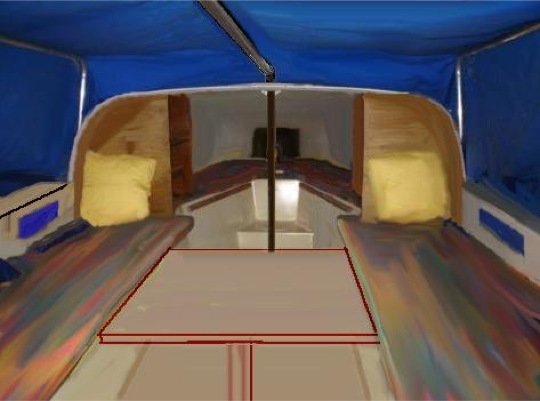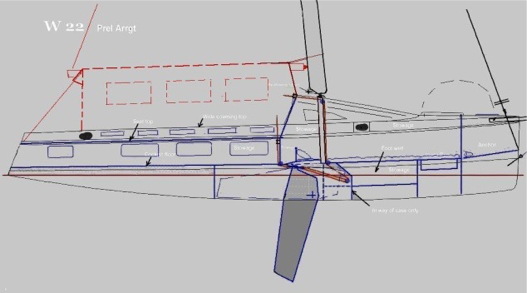



Q&A on W22 ‘Cabin Length’ & ‘Folding Systems’
QUESTION (from FP):
Do you have a version of the W22 with a smaller cockpit, but bigger cabin? Something like the L7 (no longer available) would interest me, as I want to use the boat for some cruising. Also, do you have a folding-ama option for the W22?
ANSWER (Mike):
ALL such decisions are the result of considering all the options and making the compromises necessary to stay on track for ‘the end goal of the design’. Let’s deal with this in two parts.
LONGER CABIN:
Everything is possible but there are presently no plans to make such a change on the plans. But after considering the PRO’s and CON’s that I will outline here, it’s for each builder to make their own decision.
The first boat actually extended the cabin back about 300mm (12") from the original plans, because he's a tall fellow and needed a little more space in the cuddy. The important thing in order to still be considered “a W22”, is the form of the hulls, sail plan and general length/beam of the boat. The interior and deck layout can be modified to suit the owner, as long as the weight and center of gravity are not greatly changed.
I personally believe that for a boat of just 22ft, having a good cockpit where the crew can move forward when going upwind will improve performance, and also that the boat will be sailed as a day-sailer most of the time – probably along with friends who also need space clear of the helmsman. For someone who is serious about cruising a W22, I recommend a full tent over the cockpit - attached to the cuddy ... as this will give you an enclosed area the size of a 30-footer, without the weight and expense. Even with my 26ft Dragonfly (which I sailed extensively for 16 years), I only made 5 trips of 1 week each … the rest was all either day trips or overnighters, when an enclosed cuddy can serve perfectly. So it’s to save weight and allow a longer cockpit that permit better upwind trim and of course it will cost less .. "so why penalize performance and pay more for something that may seldom be used?". At least, that was my thinking when designing the boat ;)
But if you really want to add more cabin, just think about and accept the compromises and then, ‘yes, it's possible’. See below for a proposal on the tent concept.
A FOLDING SYSTEM
The answer is much the same as for a longer cabin. ie "everything is possible but there's a cost to it in both $$ and compromises". A few designers might claim 'their solution is the best' but there are always ‘pros and cons’ about every decision and that's what makes the design process both interesting and challenging. I personally choose to not compromise overall performance too much and found a solution that is very cost-effective overall. Having the perks of folding would compromise both of those aims.
The added complexity, weight and cost of a folding system is something easy to understand … on original Farriers for example, just to buy the folding parts used to be ~US$6000 alone (~10 yrs ago), even without the added installation time and cost.
But "why will folding affect the performance? you may ask. Well, in three common ways.
- it's heavier than a demountable system
- it limits the overall beam as the folded amas cannot afford to go lower than the underside of the main hull, without risk of damage when getting the boat on its trailer.
- the support arms have to be substantial and typically require local boxing, but then, both the protruding boxes and lower arms frequently hit wave tops, making the boat significantly wetter. Both early Farriers and the folding Scarab's (and others) suffer from this - in fact, I know of a local owner who spent nearly 2000 hours building his S22 only to sell it not long afterwards after he found it ‘just too wet’ - as well as discovering folding issues with a geometry that seemed imperfect.
These negative issues are all bypassed with a demountable system - even if it takes a little longer to set up and requires more space at the ramp.
To be quite fair, the Farrier system now works very well from what I've seen, but it is also quite heavy and very expensive. Personally, I prefer the swing-arm style of the Dragonfly, as the amas not only stay 'right-side up' making stepping on-and-off the boat far easier, but by staying vertical, they also avoid getting the ama sides fouled up from sitting in dirty water and algae. But that system is also heavier than a demountable and again, significantly raises the cost, as it did when changing from the demountable D25 to the swing-arm D800.
So I hope this will help those interested, at least understand my original choice. The sliding beam system of the L7 was not expensive, but as it takes valuable interior space (and cannot be symmetrical), I'd personally not choose that option. (I did once draft out a knuckled swing arm system for a larger design, but to date, the R&D has not been completed). This new concept sought a way to reduce the overall folded length of the DF Swing-Arm system, as presently, it increases the trailered length significantly. Dragonfly have more recently made a change to reduce that aft length extension … something I had predicted some years ago.
See: 7th para [ http://www.smalltridesign.com/Trimaran-Articles/Diagonal-Stability-of-Multihulls.html ] - posted 2010.
Dragonfly Trimarans have recently pushed their amas forward, so they are now even forward of the main hull when in sailing mode. This should help improve diagonal stability - but again, 'there's always a compromise', as the more prominent bows of the amas will now be more vulnerable to damage when docking etc.
So, as mentioned at the beginning, everything in design is a compromise. But the above should at least help readers understand my personal design choice. Changes are indeed possible, but before making them, you need to carefully weigh off the compromises that you personally are ready to make, and that's seldom easy. Sometimes, even just ‘great looks’ can blind you from more practical realities ... but a boats’ appearance IS important, as it adds important pride-to-ownership that often results in better maintenance.
As one experienced owner once told me, “choosing design options can be as tough as choosing a wife, but once you’ve done it, options cease to be a factor” ;-))
PROPOSAL FOR W22 COCKPIT TENT
Here are some sketches that show the proposed cockpit tent. Small details will be worked out on the first boat that adopts the system, with the designers support, input and guidance. This solution provides lots of covered space without permanently spoiling the large cockpit and sailing fun of the boat. Most boats under 26ft or so, are mostly used for day sailing in my experience, with an occasional cruise once or twice a year, yet they are encumbered with a large cabin that is really ‘in the way’, adding not only to initial cost, but also to weight, windage and versatility, that prevents efficient day sailing. This becomes even more true, the shorter the boat is.


One may then ask, why not spread the canvas in a ‘A’ form and cover the tramps as well? Well the more surface of 'canvas' you have, the more there is to fold up and store, plus dealing with its weight – and trying to seal such an arrangement against bugs such as mosquitos is VERY difficult.
The lightest and simplest solution is to simply use small tents on the tramps, as I use on my W17 as well as I did on ‘Magic Hempel’. That works best if merely needed for sleeping, as they are light, mosquito free, store compactly and offer some privacy compared to a small, shared cabin.
"Have a question or comment about the W22? If so, feel free to use our Questions & Comments Form to submit them to the designer." —webmaster
"See the Copyright Information & Legal Disclaimer page for copyright info and use of ANY part of this text or article"